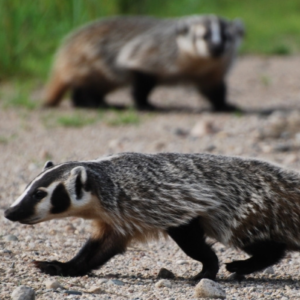Piping Plover
These birds may be small, but they’re mighty—they defend their nests fiercely from intruders by pecking and biting. Save endangered species today by joining one of our campaigns!
Help End the ExtinctionVital Signs
- Common name: Piping Plover
- Latin name: Charadrius melodus circumcinctus, Charadrius melodus melodus
- Conservation Status: Endangered
- Range: Alberta, Saskatchewan, Manitoba, Ontario (circumcinctus); Quebec, New Brunswick, Prince Edward Island, Nova Scotia, Newfoundland and Labrador (melodus)
- Life span: Average is less than 5 years, but can be as long as 14 years
- Size: weigh 43-63 g, length of 17-18 cm

The Piping Plover is a small, grey-brown bird with black markings on its breast, forehead, wings, and tail. It also has white on its wings, forehead, and behind. Piping Plovers also have bright orange legs!
Piping Plover Facts
- Interior population (circumcinctus) breeds on the coasts of the Great Lakes and in the Great Plains
- Eastern population (melodus) breed in the Gulf of St. Lawrence: on the Magdalen Islands of Quebec and on the coasts of New Brunswick, Nova Scotia, Prince Edward Island, Newfoundland and Labrador
- Nest on beaches of sand or gravel
- Males attract a mate with displays both in the air and on the ground. He must also scrape out a nest area, which the female will examine
- Nests are lined with driftwood, pebbles, and shells for camouflage

Threats
The biggest threats to the Piping Plover are caused by human activity. Piping Plovers are losing habitat to human beach use, and this also causes nest sites to be disturbed. Further, animals such as dogs and cats eat eggs and plover chicks, and so do raccoons and gulls—these two are attracted by garbage people leave behind.
Piping Plovers are also threatened by climate change, which is causing severe storms and rising sea levels. On the prairies, climate change is also causing drier conditions that aren’t suitable for this plover’s habitat and pose a risk to their populations.
What’s Being Done
This subspecies of Piping Plover (circumcinctus) is federally protected under the Species At Risk Act, and provincially protected in Ontario, Manitoba, Alberta, and Saskatchewan. It is also protected under the Migratory Birds Convention Act (1994) and by the Canadian National Parks Act (in Point Pelee National Park).
In Saskatchewan, the Quill Lakes area is recognized as an Important Bird Area (IBA).

Canada has committed to the goal of protecting 30% of lands, ocean, and freshwater in Canada by 2030. This goal will help protect ecosystems, restore habitats, and fight climate change. All these things are a step in protecting Canada’s at-risk animals—so let’s hold the federal government to their promise.
How to Help
- Be Eco-Conscious: Make sure any garbage or recycling you have at the beach is put in the proper place, or bring it home with you to dispose of properly. Don’t litter!
- Take Precautions: Keep an eye out for Piping Plovers and their nests. If you see them on the beach, leave them alone.
- Learn: Read our field notes for Eeyou Istchee and stay informed about endangered species by signing up for Nature Canada’s monthly e-newsletter.
- Find out more: Help us end the extinction by taking action for nature today—visit conservation websites like Nature Canada or join one of our campaigns!
Resources
- The Cornell Lab – All About Birds: Piping Plover
- COSEWIC – Assessment and Status Update
- Hinterland – Who’s Who: Piping Plover
- SARA – Species Profile (Charadrius melodus circumcinctus)
- SARA – Species Profile (Charadrius melodus melodus)



